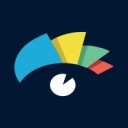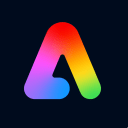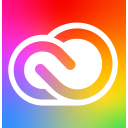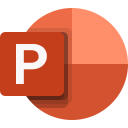Piktochart vs Canva compared: Making the best design choice
- 01Piktochart vs Canva: overview
- 02What's the difference between Piktochart and Canva?
- 03Piktochart pros and cons
- 04Canva pros and cons
- 05Piktochart compared to Canva
- 06Canva compared to Piktochart
- 07Features comparison
- 08Piktochart vs Canva: Which is the best for your business?
- 09Promotions on Design software
- 10Alternatives to Piktochart & Canva
Save up to $144 on Piktochart
Save up to $144 on Piktochart
Effectively designing stunning visuals and engaging graphics is crucial for businesses looking to establish a strong online presence. Piktochart and Canva are two leading platforms in the realm of graphic design, offering a wide range of features to create everything from social media graphics to infographics with ease.
In this comprehensive comparison, we delve into the intricacies of Piktochart vs Canva, exploring their unique features and functionalities. From intuitive drag-and-drop interfaces to extensive libraries of templates and design elements, we dissect how each platform caters to diverse design needs. Whether you're a freelance designer or part of a marketing team in a multinational corporation, this analysis will assist you in selecting the ideal tool for your graphic design endeavors.
Piktochart vs Canva: overview
Piktochart and Canva stand as prominent players in the realm of graphic design software, each presenting distinct strengths and capabilities.
Piktochart excels in its user-friendly interface and powerful infographic creation tools. With Piktochart, users can effortlessly design visually appealing infographics, presentations, and reports, thanks to its drag-and-drop editor and extensive library of customizable templates and graphics. Meanwhile, Canva offers a versatile platform for designing a wide range of visual content, including social media graphics, posters, flyers, and more. With its intuitive interface and vast collection of design elements, Canva empowers users to bring their creative ideas to life with ease.
In this in-depth comparison of Piktochart vs Canva, we'll explore the unique features and functionalities of each platform to help you determine the best fit for your graphic design projects and creative endeavors.
What's the difference between Piktochart and Canva?

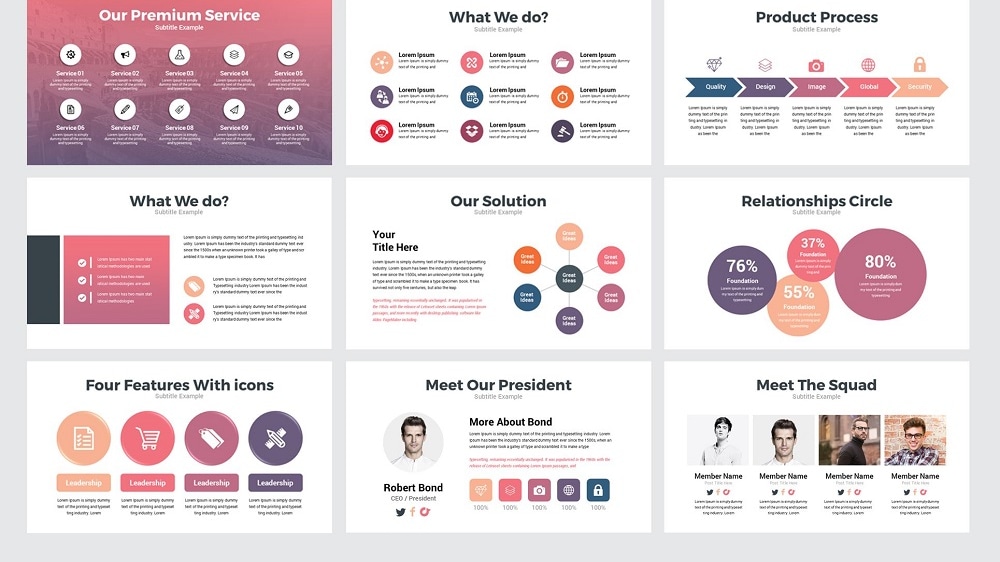
When it comes to graphic design platforms, Piktochart and Canva both offer robust tools for creating visually captivating content, but they have distinct differences that cater to varying design needs.
Piktochart is renowned for its specialized focus on creating infographics and data visualizations. Its drag-and-drop editor and extensive library of templates make it an excellent choice for users who prioritize conveying complex information in a visually appealing manner. Piktochart's emphasis on infographics sets it apart as a go-to tool for educators, marketers, and businesses seeking to present data in an engaging format.
On the other hand, Canva boasts a broader scope, catering to a diverse range of design projects beyond just infographics. With Canva, users can design social media graphics, presentations, posters, and more, thanks to its vast selection of templates and design elements. Its intuitive interface and collaborative features make it an ideal choice for individuals and teams looking to create stunning visuals for various purposes effortlessly.
One notable difference between Piktochart and Canva is their pricing models. While both offer free versions with limited features, Piktochart's premium plans are tailored towards users specifically interested in creating infographics and presentations. Canva, on the other hand, offers a more extensive range of features across its subscription tiers, making it a versatile solution for all types of design projects.
Additionally, Piktochart's focus on data visualization means it may offer more specialized features in this area, such as chart customization options and data import capabilities. Canva, on the other hand, may provide a wider array of design elements and integrations with other platforms, catering to a broader audience with diverse design needs.
Piktochart pros and cons
What are the advantages of Piktochart?
- User-friendly interface: Piktochart offers an intuitive drag-and-drop interface, making it easy for users with varying levels of design experience to create visually appealing graphics and infographics without extensive training.
- Abundant templates: Piktochart provides a wide selection of professionally designed templates for various purposes, ranging from infographics and presentations to posters and reports, saving users time and effort in starting their designs from scratch.
- Customization options: The platform offers ample customization features, allowing users to personalize templates with their brand colors, fonts, and imagery. Additionally, Piktochart provides tools for editing charts, graphs, and icons to suit specific design requirements.
- Data visualization tools: Piktochart specializes in data visualization, offering tools to import data sets and create dynamic charts and graphs. This feature is particularly useful for businesses and educators looking to present complex information in a visually engaging format.
- Collaboration features: Piktochart allows users to collaborate on projects in real-time, facilitating teamwork and enabling multiple contributors to work together seamlessly on the same design.
What are the disadvantages of Piktochart?
- Limited free features: While Piktochart offers a free version, it comes with limitations on the number of projects, templates, and images available, restricting users' creative options compared to premium plans.
- Price: The cost of Piktochart's premium plans may be prohibitive for some users, especially individuals or small businesses on tight budgets, leading them to seek more affordable alternatives.
- Learning curve: Despite its user-friendly interface, mastering Piktochart's advanced features and customization options may require some learning for users new to graphic design software, potentially slowing down the design process initially.
- Dependency on internet connection: Piktochart is a web-based platform, meaning users need a stable internet connection to access and use its features. This dependency may pose challenges for users in areas with poor internet connectivity or during periods of network disruption.
- Limited export options: While Piktochart allows users to export their designs in various formats, such as PNG, JPEG, and PDF, some users may find the export options limited compared to other graphic design tools, restricting their ability to use designs across different platforms seamlessly.
Compare Piktochart to other tools
Canva pros and cons
What are the advantages of Canva?
- Versatile design capabilities: Canva offers a wide range of design tools and templates for various purposes, including social media graphics, presentations, posters, flyers, and more, catering to diverse design needs.
- User-friendly interface: With its intuitive drag-and-drop interface and straightforward design tools, Canva is accessible to users of all skill levels, allowing them to create professional-looking designs quickly and easily.
- Extensive template library: Canva provides an extensive library of professionally designed templates, covering a multitude of design categories and styles, giving users a vast array of options to choose from for their projects.
- Collaboration features: Canva's collaboration tools enable users to work together on projects in real-time, making it easy for teams to collaborate on designs, share feedback, and streamline the design process effectively.
- Integration with other platforms: Canva integrates seamlessly with various platforms and tools, including social media platforms like Facebook and Instagram, as well as cloud storage services like Google Drive and Dropbox, enhancing workflow efficiency and enabling users to access their designs across different platforms effortlessly.
What are the disadvantages of Canva?
- Limited customization options: While Canva offers a range of design tools and features, some users may find its customization options somewhat limited compared to more advanced graphic design software, restricting their ability to create highly personalized designs.
- Watermark on free version: Designs created using Canva's free version may include a watermark, which can detract from the professional appearance of the final product and may necessitate upgrading to a paid plan for watermark-free designs.
- Subscription costs: While Canva offers a free version with basic features, unlocking access to premium templates, advanced design tools, and additional features requires a paid subscription, which may be costly for some users, particularly individuals or small businesses on tight budgets.
- Internet dependency: Canva is a web-based platform, meaning users need a stable internet connection to access and use its features. This dependency on internet connectivity may pose challenges for users in areas with poor internet access or during network disruptions.
- Export limitations: While Canva allows users to export their designs in various formats, such as PNG, JPEG, and PDF, some users may find the export options limited compared to more advanced graphic design software, potentially hindering their ability to use designs across different platforms seamlessly.
Compare Canva to other tools
Piktochart compared to Canva
Piktochart and Canva are both leading graphic design platforms, each with its unique strengths. Piktochart specializes in data visualization and infographics, offering powerful tools for creating visually compelling presentations and reports.
On the other hand, Canva provides a versatile platform for designing a wide range of visual content, from social media graphics to posters and flyers, with its extensive library of templates and design elements. While Piktochart excels in data-driven design, Canva offers greater flexibility and variety in design options.
Is Piktochart better than Canva?
Whether Piktochart is considered better than Canva can largely depend on the user's primary design needs and objectives. For individuals or organizations that prioritize data visualization and require sophisticated tools to transform complex information into clear, engaging infographics and presentations, Piktochart emerges as the more tailored solution. Its focus on enabling users to create detailed and informative visual content means it could be the preferred choice for those whose main concern is effectively communicating data.
Conversely, Canva's broader approach to design, catering to a wide array of content types, might not offer the same level of specialized functionality for data visualization as Piktochart does.
What is Piktochart best used for?
Piktochart is best used for creating visually captivating infographics and data visualizations. With its user-friendly interface and extensive library of customizable templates and graphics, Piktochart enables users to present complex information in an engaging and easy-to-understand format.
Whether it's conveying statistical data, illustrating trends, or telling a compelling story, Piktochart empowers individuals, educators, and businesses to transform data into visually appealing designs. Its specialized focus on infographics makes it an ideal tool for anyone looking to communicate information effectively and creatively, whether for presentations, reports, or marketing materials.
Can Piktochart replace Canva?
Piktochart and Canva both offer intuitive platforms for graphic design, but whether Piktochart can replace Canva depends on specific needs. Canva boasts a vast library of templates, images, and fonts, catering to diverse design requirements. It excels in user-friendliness and versatility for creating various graphics.
On the other hand, Piktochart focuses more on infographics and data visualization, offering advanced tools for storytelling with data. While Piktochart may be preferred for certain specialized tasks, Canva's broader scope and accessibility often make it the go-to choice for a wider range of design projects.
Is Piktochart cheaper than Canva?
Comparing Piktochart's pricing to Canva's reveals nuanced differences. Piktochart’s pricing structure offers a free plan with limited features and paid plans starting at $29 per month.. Canva, meanwhile, presents a similar free tier and a paid plan beginning at $12 per month per user.
While Piktochart's starting price appears higher, its subscription may be more cost-effective depending on specific needs. Both platforms offer additional features with higher-tier subscriptions.
Is there a better Design software than Piktochart?
When evaluating Piktochart for your graphic design needs, it's crucial to explore whether there might be a better-suited software available.
Several notable alternatives to Piktochart in the graphic design realm include Canva, Adobe Creative Cloud, DesignBold, and Venngage.
The decision of which graphic design software to use depends on factors such as your specific design requirements, budget, and preferred features. While Piktochart offers certain advantages, other platforms may provide a more extensive range of templates, advanced editing tools, or specialized design capabilities that better align with your project goals and preferences.
50% off the annual Business plan on Piktochart
Get 50% off the annual Business plan on Piktochart and up to $144 savings with Secret.
Canva compared to Piktochart
Canva and Piktochart stand out as leading platforms for graphic design, each with its unique strengths. Canva boasts a vast library of templates, images, and fonts, making it highly versatile for a wide range of design projects. Its user-friendly interface appeals to both beginners and professionals.
Conversely, Piktochart specializes in creating infographics and visualizing data, offering advanced tools tailored for storytelling with information. While Canva excels in general graphic design, Piktochart shines in data visualization. Ultimately, the choice between Canva and Piktochart depends on specific needs, with Canva favored for its breadth and accessibility, while Piktochart suits those focused on data-driven visuals.
Is Canva better than Piktochart?
Assessing whether Canva outperforms Piktochart requires considering the scope of design projects and the user’s priorities. Canva's broad appeal stems from its extensive collection of design resources and its intuitive interface, making it a go-to for creating diverse types of visual content efficiently. This accessibility and variety cater to a wide audience, from amateurs to design professionals, enabling the creation of everything from simple social media graphics to complex layouts with minimal effort.
On the other hand, for projects that demand detailed data representation and sophisticated infographics, Piktochart's specialized toolkit might fall short of expectations. Canva’s versatility and ease of use generally position it as a more adaptable tool for users seeking to cover a broad spectrum of design needs without the necessity for advanced data visualization capabilities.
What is Canva best used for?
Canva serves as a versatile tool for various graphic design needs. Its extensive library of templates, images, and fonts makes it ideal for creating social media graphics, posters, presentations, and marketing materials. Businesses frequently utilize Canva for designing logos, advertisements, and branding materials due to its intuitive interface and professional-quality output.
Additionally, Canva's collaborative features facilitate team projects and streamline design workflows. With its user-friendly platform and robust functionality, Canva is favored by individuals, businesses, educators, and organizations alike for producing visually appealing and engaging content across a wide spectrum of applications.
Can Canva replace Piktochart?
Canva and Piktochart offer distinct features tailored to different design needs. While Canva excels in general graphic design, providing an extensive library of templates for various purposes like social media posts, presentations, and marketing materials, Piktochart specializes in infographics and data visualization.
Canva's user-friendly interface and broad range of design options make it a popular choice for creating visually appealing content. However, Piktochart's focus on storytelling with data sets it apart in certain contexts. Whether Canva can fully replace Piktochart depends on specific project requirements, with Canva typically preferred for general design tasks and Piktochart for data-driven visualizations.
Is Canva cheaper than Piktochart?
Deciding whether Canva is superior to Piktochart hinges not just on pricing structures but also on the specific requirements and preferences of the user. Canva's appeal lies in its affordability and the breadth of its offerings, making it an attractive option for users ranging from beginners to professionals seeking extensive design tools and resources.
Piktochart might offer specialized tools that cater more effectively to users with specific needs in data visualization or infographic creation, potentially justifying its higher price point for those users.
Is there a better Design software than Canva?
When considering whether Canva is the right fit for your graphic design needs, it's crucial to explore whether there might be a more suitable software available.
Several notable alternatives to Canva in the graphic design realm include Piktochart, Visme, PicMonkey, Snappa, and Figma.
Choosing the best graphic design software depends on factors such as your specific design requirements, budget, and preferred features. While Canva offers a wide range of templates and intuitive tools, other platforms may provide more advanced editing capabilities, specialized design features, or industry-specific solutions that better align with your project goals and preferences.
Features comparison
Canva's Extensive Template Library Trumps Piktochart's Offerings

While both Piktochart and Canva provide customizable templates for various design needs, Canva boasts a significantly larger library of professionally designed templates. This abundance of templates offers users greater flexibility and choice in their design endeavors. For instance, Canva offers templates tailored for social media posts, presentations, posters, and more, catering to a wide range of design requirements.
In contrast, while Piktochart also offers templates, its selection may be more limited. Therefore, Canva emerges as the preferred tool when users seek a diverse and plentiful array of design templates to suit their specific projects and preferences.
Canva Surpasses Piktochart in User-Friendliness

When it comes to ease-of-use, Canva and Piktochart both offer accessible interfaces and intuitive design tools. However, Canva edges slightly ahead thanks to its robust collection of pre-designed templates and effortless drag-and-drop functionality.
Canva's interface stands out for its simplicity and accessibility. With well-organized toolbars and a diverse range of customizable elements, it caters to both beginners and seasoned designers alike. Its drag-and-drop feature enables users to effortlessly create visually appealing graphics. In contrast, Piktochart also provides a user-friendly platform, but newcomers may encounter a slightly steeper learning curve before fully mastering the software's capabilities.
Piktochart Excels with Interactive Data Visualization
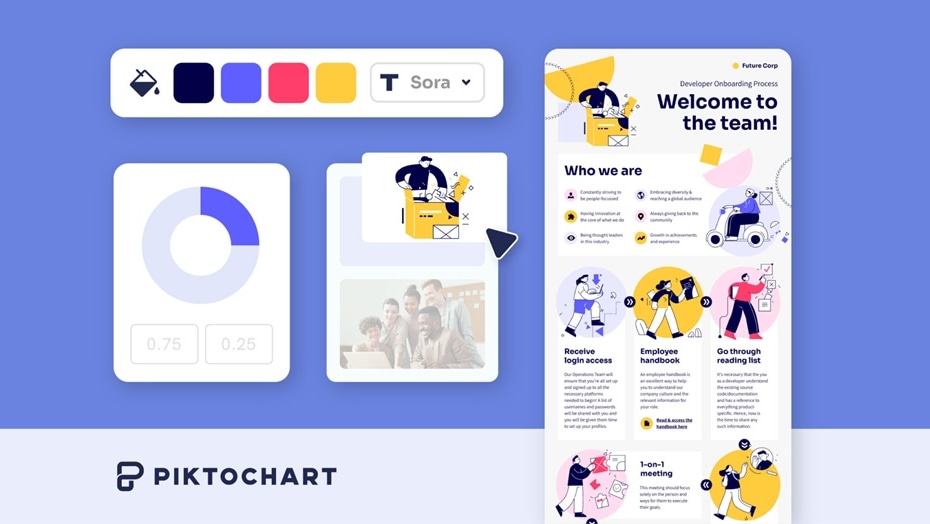
Piktochart stands out with its innovative feature allowing users to create interactive charts and maps. This functionality enables data to be presented in a dynamic and engaging format, enhancing the effectiveness of infographics and presentations.
While Canva provides elements for illustrating data, it lacks the same level of interactivity offered by Piktochart. For example, Piktochart allows users to create charts that viewers can interact with, providing a more immersive experience. Therefore, Piktochart emerges as the preferred tool for those seeking to create captivating infographics or data-driven presentations with interactive elements.
Piktochart and Canva Both Provide Collaborative Team Features

Piktochart and Canva prioritize collaboration, offering features that streamline team coordination and enhance productivity. Both platforms enable real-time editing and feedback, fostering seamless collaboration among team members. For instance, users can share designs with team members, who can then provide feedback directly within the platform. Additionally, both Piktochart and Canva allow multiple users to work on the same project simultaneously, ensuring efficient workflow management.
Whether it's Piktochart's collaborative infographic creation or Canva's team-based design projects, users can rely on either tool to facilitate smooth collaboration and maximize creativity within their teams.
Canva Leads in Integrations for Streamlined Workflows

In terms of integrations, both Piktochart and Canva facilitate seamless connections with third-party applications to enhance workflow efficiency. Yet, Canva emerges as the frontrunner in this domain, boasting a wider array of integrations.
Canva's extensive integration options enable users to seamlessly incorporate their favorite tools into their design process. For instance, it integrates seamlessly with platforms like Dropbox for easy access to stored assets and with social media platforms like Facebook and Instagram for direct sharing of designs. While Piktochart also supports integrations, Canva's broader selection provides users with more flexibility to customize their workflow according to their specific needs.
Custom Branding is Handled Best by Canva

Canva sets itself apart with its Brand Kit feature, enabling users to store and access brand-specific assets such as logos, colors, and fonts. This functionality streamlines the design process by ensuring consistency across multiple projects. For example, users can easily apply their brand colors and fonts to new designs, maintaining a cohesive brand identity.
While Piktochart also emphasizes custom branding, Canva's Brand Kit offers a more comprehensive and user-friendly solution. This makes Canva the preferred choice for users seeking a robust tool for maintaining brand consistency and identity across their designs and projects.
Canva Outshines Piktochart in Image Editing

Canva distinguishes itself with a range of built-in image editing tools, empowering users to enhance their visuals without leaving the platform. Features such as cropping, resizing, applying filters, and adjusting brightness/contrast elevate Canva's image editing capabilities. For instance, users can easily resize images to fit different design dimensions or apply filters to achieve desired visual effects.
While Piktochart offers high-quality images and icons, its image editing toolkit is more limited. This makes Canva the preferred option for users seeking comprehensive image editing features integrated seamlessly into their graphic design workflow.
Subscribe to our newsletters.
No FOMO here. Stay up-to-date on all the latest deals and news with our monthly newsletter straight to your inbox like 123,000+ entrepreneurs (+ Get 10% off on on our Premium Membership!)
Piktochart vs Canva: Which is the best for your business?
Piktochart is the best tool for you if:
- You need to create detailed infographics, presentations, or reports that require complex data visualization and appreciate a platform with specialized tools for this purpose.
- Your work involves storytelling with data, and you're looking for a design platform that emphasizes clarity and impact in visualizing information for your audience.
- You value a focused set of features designed specifically for creating professional-looking data-driven visuals, without the distraction of unrelated design options.
- You're part of an organization that frequently communicates complex information and seeks to make data understandable and engaging through visual content.
- You prioritize quality and effectiveness in data presentation over a wide range of general design capabilities, aiming for depth rather than breadth in your design tools.
Canva is the best tool for you if:
- You're looking for an all-in-one design platform that offers a wide range of templates and design elements for creating everything from social media graphics to professional presentations.
- You value an intuitive user interface that makes graphic design accessible to users of all skill levels, from beginners to professionals, without a steep learning curve.
- You need a versatile tool that supports a variety of design projects, including marketing materials, branding, and event invitations, with easy customization options.
- You appreciate having access to a vast library of stock photos, fonts, and icons that can enhance your designs without the need for additional resources.
- You're working in a team and require collaboration features that allow multiple users to edit and comment on designs in real-time, streamlining the design process.
Alternatives to Piktochart & Canva
Promotions on Design software
Start saving on the best SaaS with Secret.
Secret has already helped tens of thousands of startups save millions on the best SaaS like Piktochart, Canva & many more. Join Secret now to buy software the smart way.






